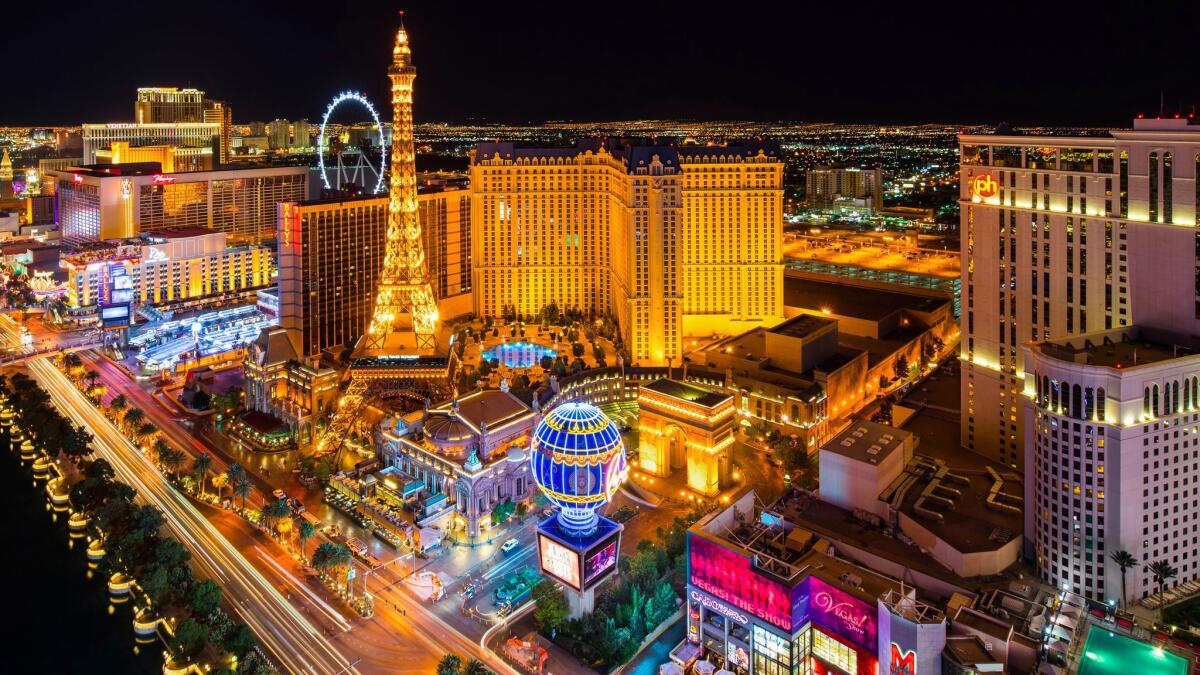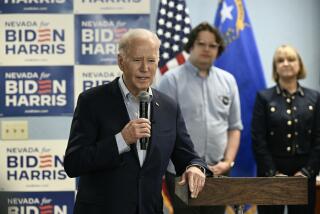Las Vegas high-speed train project, once stuck in low gear, is now moving forward

The last time a California railroad conductor hailed “all aboard for Las Vegas” was more than 20 years ago, after lines such as the Desert Wind, the Crapshooters Express and the Fun Train failed to attract riders.
Amtrak had tried to jazz up its service, enlisting comedian Milton Berle and basketball great Wilt Chamberlain. New proposals for train service since have come and gone, including one by a Spanish firm that saw a “renaissance in train travel on the horizon.”
But in recent weeks, a more concrete proposal by Florida-based XpressWest for Las Vegas train service has quietly advanced. The privately-held firm has taken key steps to secure private debt funding under bond programs operated by California, Nevada and the federal government.
If the chips fall the right way, the $4.8-billion project should have full funding for a 170-mile line along Interstate 15 and start construction later this year with trains running by 2023, the company told The Times.
“We have a lot of momentum,” said Husein Cumber, XpressWest’s chief strategy officer based in Las Vegas. “The first dominoes are starting to fall in place for the financing.”
Although credit markets are in turmoil around the world, California officials remain confident that the economic slowdown won’t affect the long-term viability of the project.
The plan calls for a high-speed electric train system from Apple Valley in the California high desert to Las Vegas, almost entirely with private funding.
On March 9, the U.S. Department of Transportation gave its approval for the project to issue $1 billion in tax-free private bonds, according to a letter federal officials sent to the company.
The bonds are technically known as “private activity bonds” that work like tax-free municipal bonds for infrastructure but are not issued or guaranteed by the government. The XpressWest bonds would have to be issued by September 30, the letter said.
The federal approval led California officials to take the next step, scheduling a state committee meeting for April 14 to approve XpressWest’s issuing another $2.4 billion in bonds under California’s share of the federal program, Treasurer Fiona Ma said in an interview.
For decades private developers and entrepreneurs have periodically announced bold plans to run high-speed trains between Las Vegas and Los Angeles.
Nevada officials are working on the third leg that would add debt financing for about $800 million for the Nevada section of the track.
It adds up to $4.2 billion with XpressWest’s parent covering the balance with about $600 million of private equity, company officials said.
“We are excited because we haven’t had a passenger train project in I don’t know how long,” said Ma, whose office is taking a key role in moving the project ahead. “I am fairly confident now. The letter approving the $1-billion allocation from the Transportation Department was the affirmation I was looking for.”
Ma said she believes the market for tax-free bonds is functioning, noting that California successfully sold issues in recent weeks.
Officials are also taking the company’s plan seriously because it has contracted with a construction team led by Skanska of Stockholm, Sweden, and has purchased land for stations, a maintenance yard and related residential and commercial development.
To be sure, many critical regulatory steps lie ahead. The FRA issued a letter in January saying it did not anticipate the need for a supplemental environmental study, but that will have to be finalized.
Caltrans provided The Times with a memorandum of understanding that would grant use of the I-15 median for the rail project, but a lease agreement will be needed, along with Federal Highway Administration concurrence.
And the company must find a ready market among investors who believe in the viability of the project for its tax-free bonds.
XpressWest is a unit of Florida East Coast Industries, which operates the Brightline passenger rail system from Miami to West Palm Beach. FECI is owned by private investment funds managed by New York City-based Fortress Investment Group. The Las Vegas line would be marketed as Virgin Trains, a brand of airline and space tourist entrepreneur Richard Branson, though he has no investment in the train.
The project is getting deep support in the economically depressed San Bernardino County high desert, including Apple Valley, Victorville, Adelanto and Hesperia.
“This is going to be the biggest shot in the arm that we have ever seen,” said Art Bishop, an Apple Valley councilman and former mayor. He expects the train to spur 600 permanent jobs and thousands of new homes in the region.
“We have all heard about the governor’s train to nowhere,” Bishop said about the California bullet train, “but that isn’t this project.”
Proponents hope that the Las Vegas line would eventualy be extended from Apple Valley to Palmdale, where it could link up to the existing Metrolink line or even the California bullet train if that is ever built.
The state bullet train authority is taking 15 years to build a 171-mile partial operating system from Bakersfield to Merced by 2028 for $20.4 billion. The XpressWest line — if everything goes as planned — would be the same distance and completed in three years at one-fourth the cost.
Still, the state bullet train authority is hoping the Las Vegas train will increase political support for its San Francisco to Los Angeles system.
Even without the extension to Palmdale, the XpressWest line would be financially successful, the company said. It would carry about 10 million passengers a year, drawn off Interstate 15, where, before the economic calamity triggered by the coronavirus, gamblers and partyers jammed the roadway.
That traffic is expected to eventually return, and when it does, XpressWest hopes to lure a chunk of those drivers —estimated at 18% — to its trains.
Not everybody is convinced the Vegas-bound crowd will become train aficionados. Paul Dyson, a past president and Southern California chapter leader of the Rail Passenger Assn. of California, doesn’t believe the end points of the route make sense.
The Apple Valley station would be a difficult one hour or longer drive through heavy congestion for most Los Angelenos and the Vegas station would be five miles south of The Strip.
“You can drive in off-peak times and get there quite easily,” Dyson said.
But proponents think the train could compete successfully on price and convenience.
The average fare, they say, would be $60, and travel time about 80 minutes to 90 minutes. The train could hit top speeds of 180 mph, though it would average about 120 mph. It would beat the best possible drive time by about an hour and possibly two to three hours when the highway is packed.
Passengers could check into their hotels at the Apple Valley train station and their bags would be waiting in their room when they arrived. There wouldn’t be any gambling on the train, but drinks would be available. Cocktailhour would begin as soon as the wheels started moving.
“It comes down to the customer experience,” said Ben Porritt, senior vice president of Brightline. “When you go to Las Vegas your vacation doesn’t really start until you get to your hotel room. But with our service your vacation starts when you board the train. You can have a glass of champagne or wine.”
More to Read
Start your day right
Sign up for Essential California for news, features and recommendations from the L.A. Times and beyond in your inbox six days a week.
You may occasionally receive promotional content from the Los Angeles Times.






